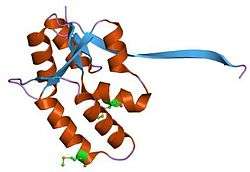PIN domain
| PIN domain | |||||||||
|---|---|---|---|---|---|---|---|---|---|
|
Crystal structure of PIN (PilT N-terminus) domain (AF0591) from Archaeoglobus fulgidus at 1.90 Angstrom resolution. 1o4w | |||||||||
| Identifiers | |||||||||
| Symbol | PIN | ||||||||
| Pfam | PF01850 | ||||||||
| InterPro | IPR002716 | ||||||||
| SMART | CBS | ||||||||
| SCOP | 3dbo | ||||||||
| SUPERFAMILY | 3dbo | ||||||||
| CDD | cd09852 | ||||||||
| |||||||||
In molecular biology the PIN domain is a protein domain that is about 130 amino acids in length. The PIN domain was named after its identification in the N-terminus of the PilT protein (PilT N terminus). PIN domains function as nuclease enzymes that cleave single stranded RNA in a sequence dependent manner.[1]
PIN domains contain three nearly invariant acidic residues. Crystal structures show these residues clustered together in the putative active site. In eukaryotes PIN domains are found in proteins involved in nonsense mediated mRNA decay, in proteins such as SMG5 and SMG6, and in processing of 18S ribosomal RNA. The majority of PIN-domain proteins found in prokaryotes are the toxic components of toxin-antitoxin operons. These loci provide a control mechanism that helps free-living prokaryotes cope with nutritional stress.[2]
References
- ↑ Arcus VL, McKenzie JL, Robson J, Cook GM (January 2011). "The PIN-domain ribonucleases and the prokaryotic VapBC toxin-antitoxin array". Protein Eng. Des. Sel. 24 (1-2): 33–40. doi:10.1093/protein/gzq081. PMID 21036780.
- ↑ Gerdes K, Christensen SK, Løbner-Olesen A (May 2005). "Prokaryotic toxin-antitoxin stress response loci". Nat. Rev. Microbiol. 3 (5): 371–82. doi:10.1038/nrmicro1147. PMID 15864262.
